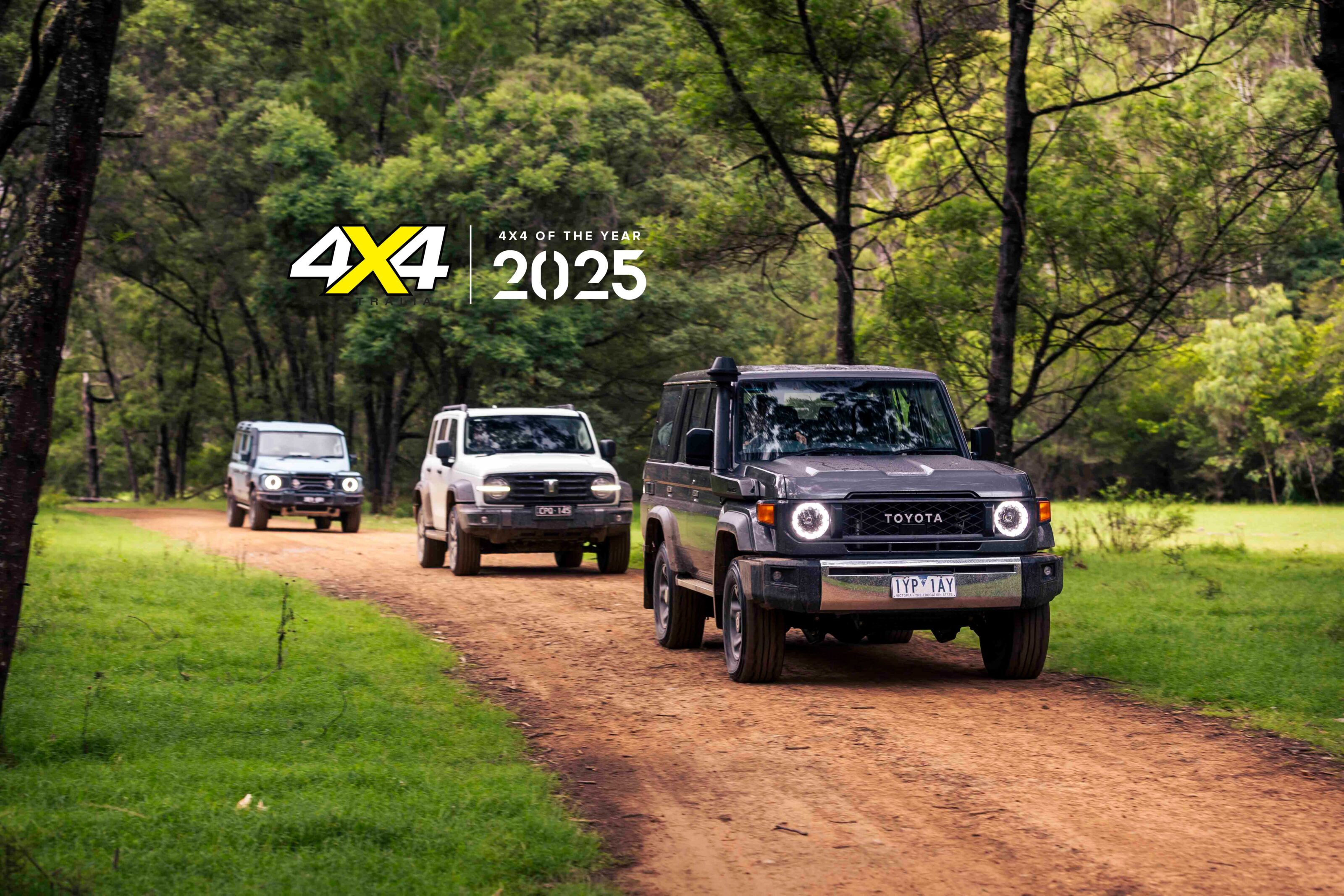IT’S THE only ute to have been driven to both the North and South Poles; it has competed in the world’s toughest cross-country rallies including the Dakar; it is the only ute to ever top Australia’s annual new-vehicle sales charts; and it has been on sale here for nearly five decades, with more than 750,000 units sold.
It is, of course, the ‘unbreakable’ Toyota Hilux, a vehicle that is found on rural properties, worksites, cattle stations, highways and in garages all over Australia.
Used by tradesmen, farmers, miners, government organisations, telecommunications companies, recreational four-wheel drivers, fishermen, caravanners, and anyone who needs a load-carrying vehicle to get them to the far-reaching corners of Australia; the versatility of the Hilux is the key to its unrivalled success. It has plenty of challengers for its throne, but no other ute comes close to the Hilux’s popularity both here and around the world.
Now in its eighth generation, today’s Hilux is available in more than 30 variants: single-cab, extra-cab and double-cab bodies; ute back and cab-chassis; two- and four-wheel drive; and three different engine options with a choice of automatic and manual gearboxes. There’s a Hilux to suit everyone, no matter your use for it.
The success of the Hilux in Australia came from early on. As the swinging ’60s drew to a close, Japanese cars were still feeling their way in the Australian market. Funny brand names such as Datsun, Toyota and Honda were relatively new and few buyers were keen to purchase the unknown cars built in Asian countries.
Australians drove Holdens, Fords, Chryslers, Vauxhalls, Morrises and anything else derived from the USA or the Old Dart. Certainly our utes came from the popular Ford and Holden brands, as only they were deemed tough and durable enough to handle the harsh local conditions. But Japanese utes from Datsun, Isuzu and Toyota were edging in, finding their niche and destined to take over the Aussie utility market.
First-Gen
The first Hiluxes were imported to Australia by then Toyota commercial vehicles distributor Thiess. Sir Leslie Thiess was the forward-thinking chap who saw the need for a good four-wheel drive vehicle in Australia, and he imported the first Land Cruisers here in the 1950s for his workers toiling on the Snowy Mountains Scheme.
Thiess also had mining and construction interests in Queensland and, shortly after the first Hilux was launched in Japan in 1968, Thiess brought them to Australia.
The first-generation RN10 Hilux replaced the Toyota Stout and was only available in two-wheel drive, single-cab configuration. Power came from a 1.5-litre four-cylinder petrol engine that made just 57kW, a far cry from the 225kW supercharged V6 that powered the TRD Hilux 40 years later.
The RN10 Hilux used a body-on-chassis configuration that remains the class standard to this day. It utilises a live axle with leaf springs at the back for optimal load bearing, and independent front suspension with wishbones and coil springs to provide a better ride for the passengers. Updates to the RN10 Hilux in 1971 included a long wheelbase model and a bigger 1.6-litre engine.
Second- and Third-Gen
The second-generation Hilux ran from 1972 through to 1978 and included updated styling and a more comfortable cabin. In ’75 a mid-model upgrade saw changes that included a bigger 2.0-litre petrol engine.
The Hilux line-up took off with the introduction of the third-generation model in 1978. Running through to 1983 the more spacious and refined third-gen Hilux saw the introduction of the four-wheel drive variants, a diesel engine and double-cab body. Since then more than half of the Hiluxes sold in Australia have been 4WDs, giving the versatile ute the go-anywhere ability of the bigger Toyota Land Cruiser.
During the 1980s the Hilux overtook the Land Cruiser as the most popular light commercial utility vehicle in Australia, a title it has a stranglehold on today.
Like the early petrol engines the new diesel of the ’80s was no powerhouse. It made just 46kW and 126Nm from its 2.2 litres. The petrol engine grew from the 2.2-litre 20R to the 2.4-litre 22R, while the 1.8-litre continued in the 2WD model. These Hiluxes were built to work hard at low speeds, and high performance was never a priority.
The four-door double-cab added greatly to the versatility of Hilux. Not only could you now haul a load in your ute, but you could carry three passengers in the backseat. This gave the ute more appeal to private buyers, where the double-cab Hilux could serve double-duty as a workhorse during the week and be a family car on weekends.
While the tray might be filled with ’barrows and tools on weekdays, it would still take push bikes, surfboards or backpacks on Saturdays, while your trusty hound could hang his head proudly from the tray on any day.
Fourth-Gen
The fourth-generation Hilux of 1983 saw another body style introduced. The Xtra-Cab was, and still is (but now simply called extra-cab), a two-door cab that is extended at the back to provide space for occasional seating or a secure spot for tools and valuables.
You wouldn’t want to carry passengers in the back for long distances, but the rear seat comes in handy. The extra-cab also has a longer load bed than a double-cab, making it great for carrying dirt bikes in the back and your mates up front.
Engine choices had by this time grown to four, with two petrol and two diesel powerplants. More powerful 3.0-litre V6 and turbo-diesel engine options also appeared for the first time during this period, as did an automatic transmission.
These later options were designed to add further appeal to the private buyer (more so than the farmer or tradie) and, at first, were only offered on top-of-the-line SR5 double-cab models.
Features such as power windows, air-conditioning and floor carpets made the utes more liveable, and Australians were coming around to the idea of using a ute as a family vehicle – but their popularity in this segment was still nothing like what it is today.
At the other end of the market Toyota introduced a basic version of the Hilux aimed squarely at tradies, with bare essential features, a 1.8-litre engine and a manual gearbox only. The interestingly named Hilux Grinner was the ute the apprentice drove to the worksite, while the boss got around in his upper-spec SR5 model. This base-spec version is called the Workmate in today’s Hilux range and has been broadened to include various engine and body configurations.
The popularity of the Hilux was also feeding a booming aftermarket industry that met the needs of owners to tailor their vehicle to their specific requirements. As a car that can be both a hardworking tool of the trade or one to conquer the Australian Outback, there is swag of parts that can be added to it.
Canopies became popular to convert the ute to a wagon-like vehicle and secure the load area, while items like bullbars, raised suspension, big tyres and driving lights were what recreational off-road enthusiasts wanted.
Specialist camper conversions are now available to fit on to the back to provide all the comforts of home to the bush traveller, while racks and bars are manufactured to support ladders, pipes, lengths of timber and other work-related hardware.
The fourth, fifth and sixth generations of Hilux continued to take the vehicle forward in terms of refinement, usability and size. The four-wheel drive models lost their truck-like, leaf-sprung live front axles for independent front suspension with torsion bars, to improve their on-road driving characteristics.
The range grew to accommodate more models to suit the growing number of buyers, and the Hilux was made in factories all over the world and not just Toyota’s native Japan.
In 1991 Toyota did a deal with Volkswagen to sell a variant of the fifth-gen Hilux in Germany badged as a Volkswagen Taro. The name signified VW would one day release its own ute, even if that didn’t come for another 20 years with the Amarok.
The seventh-generation Hilux appeared in 2005 and was manufactured in Thailand, where the majority of utes of this style are now made. With coil-sprung independent front suspension and levels of performance, safety, style and comfort to match many conventional passenger cars – while maintaining its rugged purpose-built demeanour and unbreakable reputation – it was a far cry from the humble mini-truck that debuted more than 40 years earlier. It rode the wave of popularity as more buyers chose the versatility and functionality a dual-cab ute can provide.
The modern engines used included a 2.7-litre petrol engine only available in the 4×2 Workmate, while most of the models used either a 4.0-litre V6 or a 3.0-litre turbo-diesel.
In 2008, Toyota Australia debuted the TRD (Toyota Racing Development) brand, with the TRD Hilux being one of two TRD models alongside the TRD Aurion sedan.
The TRD Hilux SL4000 featured a supercharged 4.0-litre V6 petrol engine, Bilstein-tuned sports suspension and a bespoke body kit, but the project was short-lived, getting axed at the end of 2008 with just 351 TRD Hilux models produced.
Seventh-Gen
The seventh-gen ’Lux scored a few facelifts during its tenure before it was replaced by the eighth-gen model towards the end of 2015. The new and still current model saw the venerable 1KD 3.0-litre diesel replaced with a new 1GR 2.8-litre engine that was also fitted to the Prado and Fortuner wagons around the same time.
The 4.0-litre petrol V6 continued to sell alongside the four-cylinder diesel in low numbers until it was axed at the end of 2017, while the 2.7-litre petrol and a 2.4-litre variant of the 1GR continue to be sold in lower specification and 4×2 models.
The huge range of current Hilux models and variants are priced from around $21,000 for the Workmate 4×2 cab-chassis, up to more than $55,000 for an SR5 4×4 double-cab. Compare that with the $2000 a brand-new RN10 Hilux would have set you back in 1969 and you can see how far they’ve come; although, a good condition, road-going RN10 is now rare and would fetch more than its original price if you could find one.
In the face of fierce competition from new utes – VW Amarok, Ford Ranger, Isuzu D-MAX, Mazda BT-50, Holden Colorado, Mitsubishi Triton, Nissan Navara, and a new wave of vehicles coming from China – the Hilux continues to develop to maintain its spot in the minds of fleet and private buyers, hence why it remains in the top spot on the sales charts.
Hilux vs The World
With the Ford Ranger challenging the Hilux’s top spot in 4×4 ute sales and, in fact, taking it in 2017, Toyota isn’t resting on its laurels.
Fresh Hilux variants go on sale this month with the Rogue, Rugged and Rugged X editions accessorised to appeal to a broader market than the traditional tradie and man-on-the-land buyer. Top-of-the-range utes such as the Hilux SR5 continue to grow in popularity, showing an appetite for utes that are more refined, safer and, in some ways, more sporty.
New utes such as the Mercedes-Benz X-Class and Ford Ranger Raptor will see prices higher than the segment has ever seen before, and you can bet Toyota will deliver a Hilux to compete with them. As such, we can expect more of these top-end models to be launched to market, taking the price of the Hilux and its competitors well into the $70,000 bracket and beyond.
The traditional Aussie ute might be dead, but our appetite for 4×4 light trucks is as aggressive as ever, and as long as that is still the case, light trucks like the Hilux will continue to be an important part of the landscape.

MORE: Toyota Hilux Range Review MORE: Toyota Hilux Specs, Range & Price






